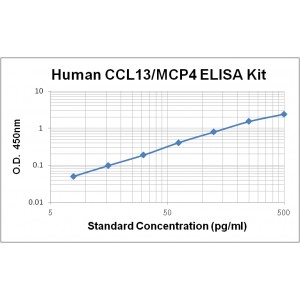More info
Assay Range | 7.8 - 500 pg/mL |
Sensitivity | 10.0 pg/mL |
Size | 96T |
Storage | Store at 2 - 8ºC. Keep reconstituted standard and detection Ab at -20 ºC |
Assay Principle | Sandwich ELISA |
Sample Volume | 100 µL final volume, dilution factor varies on samples |
Detection Method | Chromogenic |
Kit Components
1. Recombinant Human CCL13 standard: 2 vials
2. One 96-well plate coated with Human CCL13 Ab
3. Sample diluent buffer: 12 mL - 1
4. Detection antibody: 130 µL, dilution 1:100
5. Streptavidin-HRP: 130 µL, dilution 1:100
6. Antibody diluent buffer: 12 mL x1
7. Streptavidin-HRP diluent buffer: 12 mL x1
8. TMB developing agent: 10 mL x1
9. Stop solution: 10 mL x1
10. Washing solution (20x): 25 mL x1
Background
C-C motif chemokine 13 (CCL13), also known as CK-beta-10, monocyte chemoattractant protein 4 (MCP-4), NCC-1, or small-inducible cytokine A13, is a small cytokine belonging to the CC chemokine family. Human CCL13 is synthesized as a 98 amino acid (aa) precursor protein with a 23 aa hydrophobic signal peptide and a 75 aa mature protein characterized by a pyroglutamate proline motif found in other human MCP proteins. Human CCL13 is most closely related to MCP-1, MCP-3 and Eotaxin, and shows approximately 65- 66% aa sequence identity. Expression of CCL13 has been observed in endothelial cells, macrophages, bronchial epithelium and type II alveolar cells and is induced by the inflammatory cytokines interleukin-1 and TNF-α. CCL13 exhibits chemotactic for monocytes and eosinophils, CD4+ and CD8+ T cells. CCL13 binds the CC chemokine receptors CCR2 and CCR3 to transduce its signals in target cells. CCL13 also plays a role in the accumulation of leukocytes during allergic and non-allergic inflammation. It may be involved in the recruitment of monocytes into the arterial wall under the pathological process of atherosclerosis.


